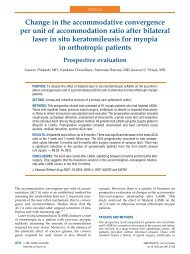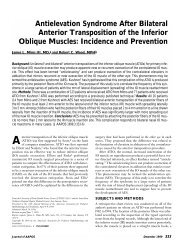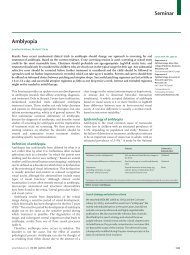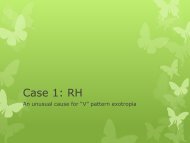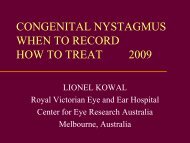What's new AAPOS 2008 - The Private Eye Clinic
What's new AAPOS 2008 - The Private Eye Clinic
What's new AAPOS 2008 - The Private Eye Clinic
Create successful ePaper yourself
Turn your PDF publications into a flip-book with our unique Google optimized e-Paper software.
Three genes have been identified in patients with JSRD: NPHP1, AHI1, and CEP290.<br />
Homozygous deletion of the NDHP1 gene is causative in 1-2% if JSRD patients with a<br />
distinctive form of the MTS, retinal dystrophy in some, and juvenile nephronophthisis.<br />
Mutations in the AHI1 gene are causative in 10-15%, many of whom exhibit retinal<br />
dystrophy, and in some polymicrogria or later onset nephronophthisis. Mutations in the<br />
CEP290 gene, causing 10% of JSRD are associated with retinal dystrophy and/or<br />
congenital blindness, as well as renal disease in some. Two other JS loci have been<br />
published (9q34 and pericentromeric 11), but the causative genes not yet identified.<br />
<strong>The</strong>y recommend that patients with JSRD be monitored with regular eye exams for<br />
retinal dystrophy and periodic evaluations for renal disease and hepatic fibrosis.<br />
Genotype/phenotype correlation in 325 individuals referred for a diagnosis of<br />
tuberous sclerosis complex in the United States.<br />
Au KS, Williams AT, Roach ES, Batchelor L et al.<br />
Genet Med 2007; 9(2):88-100<br />
<strong>The</strong> authors performed mutational analysis for the TSC1 and TSC2 genes on 368<br />
randomly ascertained index cases and compared this with the major and minor<br />
diagnostic features and neurobehavioral features to describe the genotype/phenotype<br />
association. Mutations were identified in 72% of the de novo cases, and 77% of the<br />
familial cases. No mutation was identified in 29% and 4% were unclassified. <strong>The</strong><br />
individuals with TSC2 mutations had more severe symptoms. Despite the highly<br />
variable expressivity of TSC phenotypes, this study indicated that male patients have<br />
more severe neurologic phenotypes than females. By utilizing meta-analysis of this<br />
data, coupled with data from the other 2 largest studies they were able to demonstrate<br />
that the major diagnostic features, including facial angiofibromas, foehead plaques,<br />
subependymal nodules, renal angiomyolipomas and cysts, retinal phakomas, and<br />
mental retardation are significantly associated with mutations in the TSC2 gene.<br />
Additionally male patients showed more frequent neurologic and eye symptoms, renal<br />
cysts, and ungual fibromas.<br />
Congenital malformations of the eye and orbit.<br />
Guercio JR, Martyn LJ.<br />
Otolaryngol Clin North Am 2007 Feb; 40(1):113-40.<br />
This is an excellent review article discussing not only the embryology, but also specific<br />
congenital malformations and the developmental genes. <strong>The</strong> authors describe the four<br />
proposed categories of congenital anomalies: 1) single morphogenetic defects, (2)<br />
intrauterine mechanical constraint on an otherwise normal embryo or fetus, (3)<br />
destruction of a normal structure, and (4) dysplasia, defined as a defect in the<br />
differentiation and organization of a tissue. Many of the dysplasias are caused by a<br />
60



